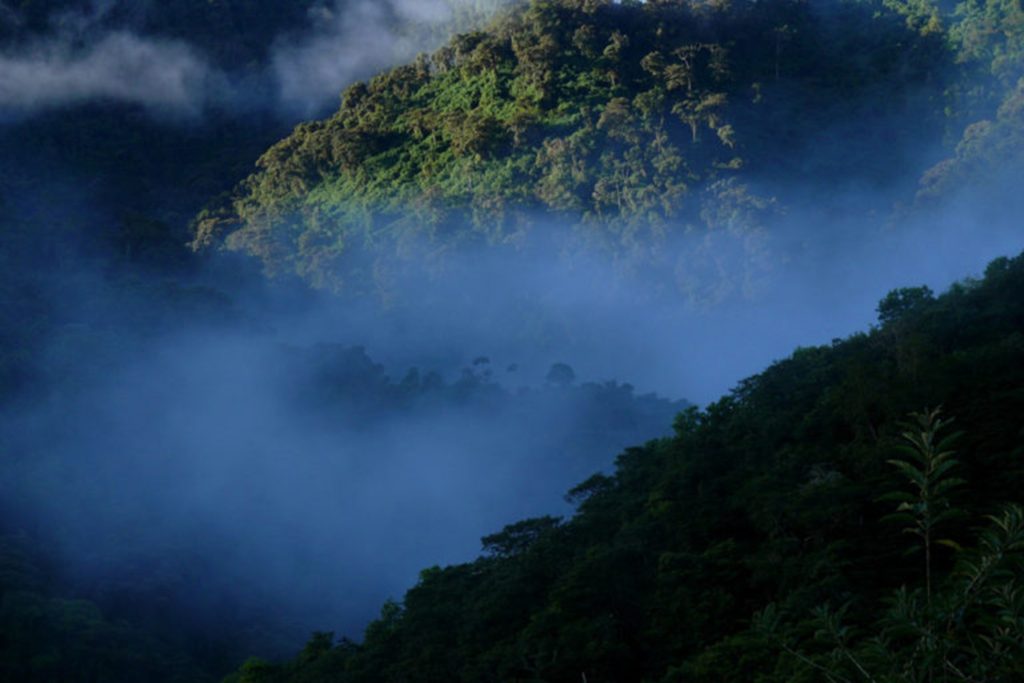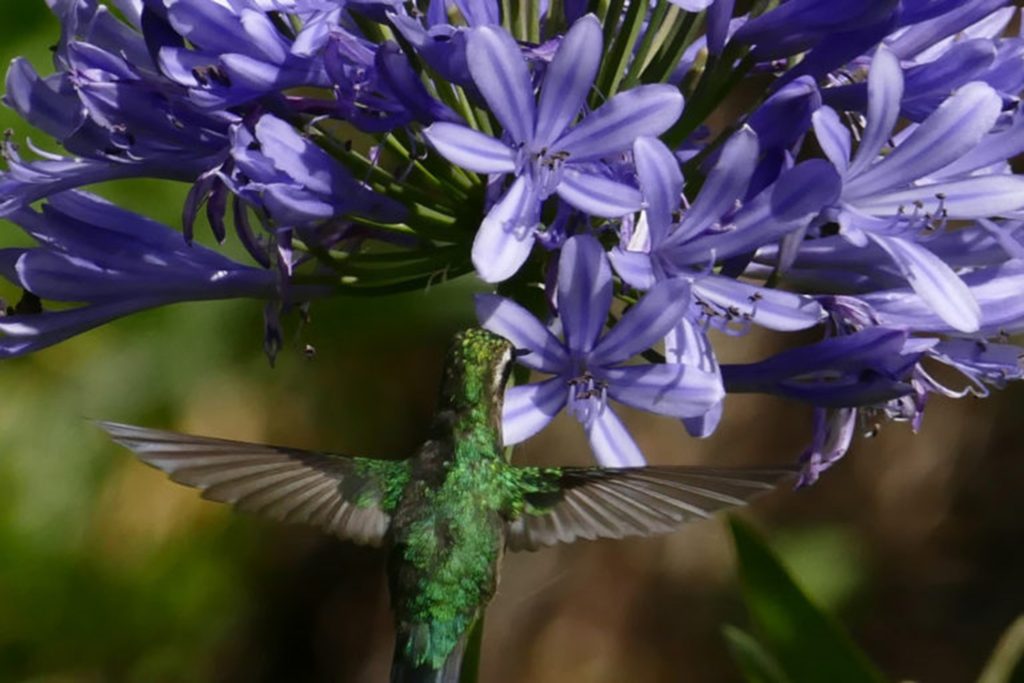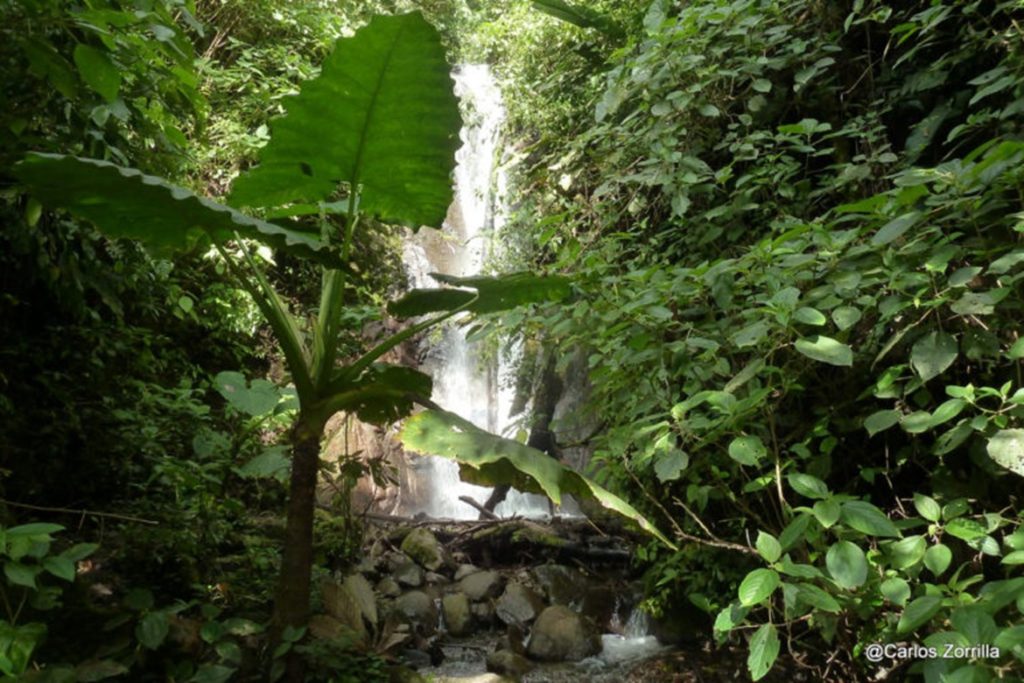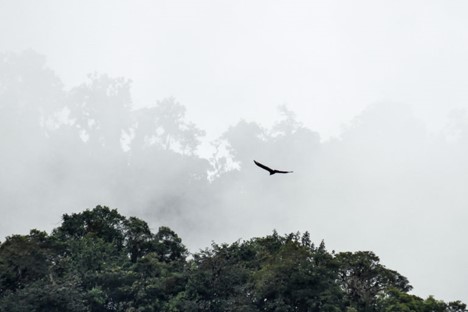Mongabay Latam
Doménica Montaño October 13, 2020

On September 24, 2020, a judge accepted an action to protect the valley and its biodiversity. The decision could save dozens of endangered species.
*This report is a journalistic alliance between Mongabay Latam and GK of Ecuador.
In the valley of Intag, two ecosystems come together: a part of the Ecuadorian Chocó -a priority area for world conservation- and the Tropical Andes -the hotspot with the greatest biological richness on the planet. In this extensive valley in the province of Imbabura, in northern Ecuador, its inhabitants have for almost three decades confronted the Ecuadorian State to avoid mining. Since 2011 they have focused their efforts on stopping, in particular, the Llurimagua project. Nine years later, they have succeeded: on September 24, 2020, a judge granted them a protection action and precautionary measures to take care of nature.
The frogs led the fight. The lawsuit filed by the biologist Andrea Terán says that the mining industry in Llurimagua is an imminent and serious threat to the endangered Harlequin Longnose frog (Atelopus longirostris) and Confusing Rocket Frog (Etopoglossus confusus). The International Union for the Conservation of Nature (IUCN) Red List classifies the Confusing Rocket Frog as an Endangered species, while the Harlequin Longnose remains on the list of extinct species – because it was believed to be extinct until 2016 and the list has not yet been updated. Both species are quite vulnerable because they only exist in this place and that is why Terán believes that it was because of them that the judge ruled in favor of the precautionary measures. “The victory of the frogs is the victory of all,” he says.
According to a study published in the Tropical Conservation Science Journal in 2018, Intag Valley protects several Endangered and other Critically Endangered species from extinction. In addition, it is home to mammals, birds, amphibians, and plants that are unique to the cloud forest and paramo ecosystem, including the spectacled bear, Andean tapir, black-breasted puffleg hummingbird, Tandayapa Andean toad and the spider monkey. All these species were at risk from the mining industry in Llurimagua and now, with the precautionary measures and protective action, that could change.
A struggle of almost thirty years
The mining history in Intag dates back to the 1990s when the Japanese company Bishimetals, a subsidiary of Mitsubishi, began mining exploration in the area. In the 4829 hectare concession – some 75 times the size of La Carolina de Quito Park – there are believed to be approximately 2.26 million tons of copper – enough to build 90 statues of La Libertad.
Concern about mining began in the communities, and in 1995 the Defensa y Conservación Ecológica de Íntag (DECOIN), an organization created to care for the region’s forests, was formed. A year later, the company presented the local inhabitants with an environmental impact study that, according to DECOIN, showed that the Japanese project would contaminate the rivers and that the forests would be destroyed. Then, resistance grew stronger, and in 1998, says DECOIN activist and co-founder Carlos Zorrilla, the Bishimetals company left Intag.

But the opposition did not end there. In 2004, the Canadian company Ascendant Copper, which later changed its name to Copper Mesa, arrived in Intag to take over the mining concession areas that belonged to Bishimetals. The locals immediately opposed it.
A report on the case by Corporate Europe Observatory – a research group working to expose corporate malpractice – says that the Canadian mining company allegedly engaged in activities that threatened the environment and the integrity of the communities. The issue escalated to the point that, in 2005, residents of the Valley of Intag burned down a company camp.
The anti-mining resistance had another victory in 2008 when Ascendant Copper left Intag and Ecuador. In April of that year, the National Assembly approved the Mining Mandate and with it, around 80% of the mining concessions in the country were extinguished, including that of the Canadian company.
However, in January 2009, the Mining Law was passed that triggered large-scale mining projects in the country. The law was widely rejected by social groups that mobilized in various areas of the country to demand its repeal, but went unheeded. A year later, in 2010, the Constitutional Court declared the law constitutional and then President Rafael Correa ordered the creation of the National Mining Company (Enami EP). The mining projects once again haunted the valley of Intag.
Mining returned to the area in November 2011, when the Ministry of Non-Renewable Natural Resources handed over the Llurimagua mining concession to Enami EP. That same month, the company signed an agreement for mining exploration in the area with Chile’s National Copper Corporation (Codelco). Again, another confrontation between the valley’s communities and the mining industry began.

Carlos Zorrilla, who has lived in Íntag for 42 years, says that Enami tried to socialize the project’s economic benefits for the local community and, although official authorities say there was no opposition, the reality was different. Zorrilla says that the majority of people rejected Enami’s proposals and that’s why, in May 2014, the company brought more than 300 police to enter the area of the concession that had been abandoned since the Canadian mining company left. Their intervention was just as big as that of Bishimetals and Ascendant Copper: by 2018, ENAMI and Codelco had drilled 90 exploratory wells.
In 2019, the Ombudsman’s Office and the State Comptroller General’s Office made observations about irregularities in the project. However, no concrete action was taken and the fight against Codelco seemed to not let up.
Mongabay Latam communicated with Enami, but as of the time of publication of this report, no response had been received.
Frogs at the head
After decades of confronting mining, the claims of the community were heard. On September 24, a judge in the city of Cotacachi granted a protection action and precautionary measures against the Ministry of Environment and Water (MAAE). In addition, the State Attorney General’s Office demanded responses regarding the effects of the Llurimagua mining project. With this decision, dozens of endemic species of amphibians, birds, and mammals living in Intag will be protected. At least 58 are Endangered, and more are Critically Endangered.
The ruling is very important for nature, but it is particularly important for amphibians, say experts and residents of Intag. Ecuador is one of the countries with the highest number of amphibians per square meter in the world, says biologist Andrea Terán. In addition, most of the species in this group that are at risk of disappearing are found in mountainous cloud forests such as those in the Valley of Intag.
There are two species of frogs that benefit from precautionary measures and protective action. These are the Harlequin Longnose Frog – which was rediscovered in 2016 after not being seen since 1989 – and the Confusing Rocket Frog.

Santiago Ron, herpetologist and curator of the zoology museum at the Pontificia Universidad Católica del Ecuador (PUCE), says that frogs play a very valuable role in ecosystems because they are part of the energy and food flow chain. Ron explains that they are predators that feed on insects and small animals that are in plants and leaf litter and, in turn, are prey to other animals. Their presence allows for the flow of energy and food that is indispensable for the forest to maintain its functioning.
Without them, the ecosystem would lose its balance and more species, which are part of that chain, would run the risk of extinction. Ron, who also belongs to The World Academy of Sciences (TWAS), believes that the judge’s decision to grant the protection action gives a lot of hope to the species in Intag, since if the mining industry continues in its habitat “its extinction would be inevitable” and that would be a biological loss not only for Ecuador but for the world
A Model to Follow
According to the records of the Judiciary Council, never before had a court in Imbabura province accepted an action for protection with precautionary measures to protect nature. In fact, the initial claim was only for precautionary measures, but the judge added the protective action after finding that there was damage in need of reparation.
This is not an unjustified decision. Human rights lawyer Vivian Idrovo explains that article 436 of the Ecuadorian Constitution allows for this kind of amendment. In the case of precautionary measures, for example, if a judge notices that the claims are not classified as a threat to a right but as a violation of a right, he or she must change the request, and process the precautionary measures that were requested at the beginning along with the other guarantee that applies – in this case the action for protection. The fact that the change has been ordered is significant and demonstrates the high impact of mining in Intag and the importance of this case.

Photograph of Intag Life Sanctuary.
The ruling – which has not yet been issued in writing – generally orders the Ministry of the Environment and Water (MAAE) to comply with the observations made by the Comptroller’s Office regarding the damage caused by the Enami and Codelco in the area. If the Ministry does not complete these processes within three months, the environmental license it granted to the project in 2014 must be revoked.
Activist Carlos Zorrilla believes this is good news. Above all, because other actors from civil society, local governments, and academia will participate. Zorrilla says that by involving more people, especially academics whose job it is to present scientific evidence, “the MAAE is going to have to do things right”. In this way, he says, it will be possible to make sure that everything is correct and avoid deforestation and contamination of Intag’s water. Mongabay Latam asked for an official statement from the Ministry of Environment and Water (MAAE), but as of the time of this writing, we have not received a response.
Although the ruling is important, biologist Terán believes that there is no room for complacency. The MAAE said they will appeal the judge’s ruling. For Terán, who filed the lawsuit, this sentence is just a battle of the war. She believes that with the appeal comes an enormous struggle. In the first place, it is a battle against two big actors: an industry that moves millions of dollars a year, and a Ministry that, according to biologist Santiago Ron and activist Carlos Zorrilla, “is not on the side of nature”. Furthermore, it will not be easy to oppose the extractive activities when the government today is handling the narrative that mining is going to get the country out of the economic crisis.
However, neither scientists nor communities are losing hope. The initial ruling in favor of protective action is already considered historic. They are convinced that history can be made to protect the rights of nature in the country.
*Main image: Intag is home to several endangered frog species, the Harlequin Longnose Frog being one of them. Photo: Gustavo Pazmiño.
Original article in Spanish: https://es.mongabay.com/2020/10/ranas-le-ganan-a-la-mineria-en-ecuador/
Translated with DeepL
